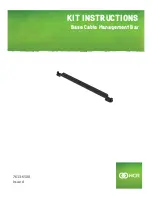
7–7
T-354
7.7
REFRIGERANT CHARGE
7.7.1
Checking the Refrigerant Charge
NOTE
To avoid damage to the earth's ozone layer, use a refrigerant recovery system whenever removing
refrigerant. When working with refrigerants you must comply with all local government environmental
laws. In the U.S., refer to EPA section 608.
1. Connect the gauge manifold to the compressor dis charge and suction service valves. For units operating
on a water cooled condenser, change over to air-cooled operation.
2. Bring the container temperature to approximately 1.7
°
C (35
°
F) or -17.8
°
C (0
°
F). Set the controller set point
to -25
°
C (-13
°
F) to ensure that the suction modulation valve is at maximum allowed open position.
3. Partially block the condenser coil inlet air. Increase the area blocked until the compressor discharge pres-
sure is raised to approximately 12kg/cm
(175psig).
4. On units equipped with a receiver, the level should be between the glasses. On units equipped with a water-
cooled condenser, the level should be at the center of the glass. If the refrigerant level is not correct, con-
tinue with the following paragraphs to add or remove refrigerant as required.
7.7.2
Adding Refrigerant to System (Full Charge)
1. Evacuate unit and leave in deep vacuum (refer to
).
2. Place cylinder of R-134a on scale and connect charging line from cylinder to liquid line valve. Purge
charging line at liquid line valve and then note weight of cylinder and refrigerant.
3. Open liquid valve on cylinder. Open liquid line valve half-way and allow the liquid refrigerant to flow into the
unit until the correct weight of refrigerant (refer to
) has been added as indicated by scales.
NOTE
It may be necessary to finish charging unit through suction service valve in gas form, due to pressure
rise in high side of the system (refer to section paragraph
).
4. Backseat manual liquid line valve (to close off gauge port). Close liquid valve on cylinder.
5. Start unit in cooling mode. Run approximately 10 minutes and check the refrigerant charge.
7.7.3
Adding Refrigerant to System (Partial Charge)
1. Examine the unit refrigerant system for any evidence of leaks. Repair as necessary (refer to
).
2. Maintain the conditions outlined in
.
3. Fully backseat the suction service valve and remove the service port cap.
4. Connect charging line between suction service valve port and cylinder of refrigerant R-134a. Open the
VAPOR valve.
5. Partially frontseat (turn clockwise) the suction service valve and slowly add charge until the refrigerant
appears at the proper level.
7.8
COMPRESSOR
WARNING
!
Make sure power to the unit is OFF and power plug disconnected before replacing the compressor.
NOTE
1. The compressor should not operate in a vacuum greater than 500mm/hg (20 inches/hg).
2. The service replacement compressor is sold without shutoff valves (but with valve pads), and without termi-
nal box and cover. Customer should retain the original terminal box, cover, and high pressure switch for use
on replacement compressor.
Summary of Contents for 69NT40-541-306
Page 2: ......
Page 4: ......
Page 10: ......
Page 14: ......
Page 142: ...T 354 8 2 Figure 8 2 Schematic Diagram Standard Unit Configuration BASED ON 62 66686 00 ...
Page 148: ...T 354 8 8 ...
Page 152: ......
Page 153: ......
















































